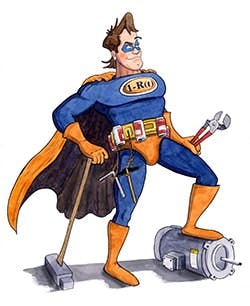Paul, a plant manager from Kansas City, writes:
“Dear Captain: Safety is a big concern for all of us. Can you speak to the importance of PPE?”
Paul, absolutely. As any plant manager can attest to, safety is a key aspect of business performance. Even more important is the safety of your position as plant manager. Let’s take a look at how PPE can ensure your safety and ensure that plant performance is exactly where you “think” it is.
PPE, or performance-protecting equipment, is designed to protect you from the harsh realities of your plant performance. Let’s be honest here: The further we can separate ourselves from reality, the easier it will be to project to the board that everything is OK. And let’s face it, as long as we tell them everything is OK and on track, they leave us alone.
No one ever really looks at the pesky fine details such as throughput vs. designed rates, cost to produce, or profitability. They’re late for tee times, fake plant tours where they see only what we want them to see, and figurehead speeches at important kickoffs for teams that will ultimately spend the next 12 months meeting four hours per week to come up with “we should outsource it.”
The best way to keep these folks in the dark and to prepare you for your next promotion is to ensure that you’re in the dark, too. Let’s learn how.
Taking precautions against maintaining any sense of reality is your best bet for being able to project sound performance to your leadership team with a clear conscience. We start our list of PPE with an easy proactive approach: Fill your calendar. If you spend 10–12 hours per day in meetings, how can you possibly be at the plant floor getting straight answers and witnessing poor performance?
Now, there are risks with this approach, such as having meaningful meetings, or meetings that review actual performance data. Avoid these risks by creating a false sense of importance for initiatives that cannot improve plant performance. Consider a complete reorganization of the staff, or perhaps drive a new records management system, and meet regularly to discuss the progress of realigning your existing records management to the new system. Any efforts that simply “repaints the walls” will work just fine. As a matter of fact, you could meet to discuss new wall colors.
If you are unable to completely avoid the risks associated with working on the plant floor, you will need to move to more direct performance protecting equipment. First on our list of direct methods would be a blindfold. Unlike safety glasses, which allow reality to simply pass right through, a blindfold will keep you in the dark, literally. Any risk of witnessing the realities of poor performance can effectively be eliminated through use of your blindfold. Be sure to get one that completely blocks out any enlightenment that could creep through.
Even though you can no longer witness poor performance, others could open your eyes through their words. That’s why the next PPE item I recommend is ear plugs. These can not only lower the overall decibel level, but also, if you choose the right pair, they can cancel out noise entirely. Nothing can diminish your lack of understanding more than hearing the truth.
As you will no longer be able to see or hear, it will be important for you to wear your foot protection. I recommend that steel- or composite-tipped safety shoes be worn at all times. In my years of watching cartoons and “The Three Stooges,” I’ve learned that if you want to distract someone, you can easily do so by stomping on their foot.
With your safety shoes in place, you can confidently know you are avoiding the risk of someone distracting you with a foot stomp, which could prompt you to remove your blindfold and/or ear plugs and give you a dose of reality. An ounce of prevention is worth a pound of cure, and it saves a pounding on your feet, too.
As for the bottom, the same goes for the top: Next up is your hard hat. If you are going to walk around in the dark and unable to hear, your chance of bumping into something and hurting your head increases significantly. You probably guessed that you need a hard hat for this reason. You guessed wrong.
Captain Unreliability is a satire of the state of the manufacturing industry in ’Merica today and is written by an industry professional known for using humor to get the point across. Stay tuned for more useless advice, and if you have topics you’d like to see covered or questions you’d like The Captain to weigh in on, contact The Captain directly at [email protected] or follow on Twitter @CUnreliability.
The hard hat in fact serves a much higher purpose. The last thing you want is to go through all the work of wearing your performance protecting equipment only to have someone knock some sense into you. Wearing an approved hard hat will ensure that any attempts to knock some sense into you or give you knowledge through osmosis are unsuccessful.
That’s a lot of protective equipment, but I have one final additional recommendation. As no safety procedure can be failsafe, we must take another precaution against the threat of being informed. For this, we require arc-flash-rated clothing. Properly worn arc-flash-rated materials can help you avoid the shocking truth about plant performance, witnessing it in action, or hearing from your frontline personnel.
I hope that use of this list of performance protecting equipment (PPE) helps you achieve your safety goals and sets you on a path to senior leadership.
Good luck, Paul.

